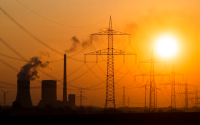5 July 2010Juliette Jowit and Christine Ottery
The world is heading for an average temperature rise of nearly 4C (7F), according to analysis of national pledges from around the globe. Such a rise would bring a high risk of major extinctions, threats to food supplies and the near-total collapse of the huge Greenland ice sheet.
More than 100 heads of state agreed in Copenhagen last December to limit the rise in global temperatures to 1.5C-2C (2.7-3.6F) above the long-term average before the industrial revolution, which kickstarted a massive global increase in the greenhouse gases blamed for warming the planet and triggering climate change.
But six months on, a major international effort to monitor the emissions reductions targets of more than 60 countries, including all the major economies, the Climate Interactive Scoreboard, calculates that the world is on course for a rise of nearly double the stated goal by 2100.
Another study by Climate Analytics, at the Potsdam Institute in Germany, suggests there is "virtually no chance" world governments will keep the temperature rise to below 2C, and the rise is likely to be 3.5C (6.3F) by the end of the century.
In both analyses the current commitments suggest a much better outcome than the estimated business-as-usual temperature rise of 4.8C (8.6F), but are well above the 2C maximum the UN hoped would be agreed at the next major meeting this December in Cancún, Mexico – and even further from the 1.5C target many developing nations argue is needed to stop the worst impacts of climate change in their countries.
In its last assessment of the problem in 2007, the Intergovernmental Panel on Climate Change (IPCC) forecasts that a rise of more than 2C would lead to potential increases in food production, but an increasingly high risk of extinction for 20-30% of species, more severe droughts and floods, and a unstoppable "widespread to near total" loss of the Greenland ice sheet over very long time periods. However, at 4C it predicted global food production was "very likely" to decrease, "major extinctions around the globe", and near-total loss of Greenland's ice, precipitating 2-7m of sea-level rise in the long term. As temperatures rose, the severity of floods, erosion, water pollution, heatwaves, droughts and health problems such as malnutrition and diarrhoea diseases would also increase, said the IPCC.
"We're looking at a level which is much more extreme and profoundly dangerous," said Ruth Davis, chief policy adviser for Greenpeace. "It's arguable the UN process has become dangerously cut adrift from the science of climate change."
The Department of Energy and Climate Change said that, based on national offers of emissions reductions made in Copenhagen, the United Nations Environment Programme (Unep) and other bodies had calculated that it was possible to meet the 2C target, although this would depend on the targets set beyond 2020.
"There's more work to do if we're going to avoid a 2C temperature rise which is why we're pushing the EU to cut its emissions by 30%," said a DECC spokesman. "Keeping below 2C is still possible from the high end Copenhagen accord offers, but will require steeper action after 2020."
However, many experts said the much higher temperature-rise estimates were a cause for serious concern that emissions cuts proposed for Cancún were too low and not enough was being done to prepare for further cuts beyond 2020, even though there are still nearly six months of negotiations before the talks.
"We've made progress but we're clearly not headed where we need to be," said Andrew Jones, co-director of Climate Interactive, which is backed by several universities including MIT. "No one is talking about changing any of the 2020 proposals, so we should be worried." Climate Interactive's model is also backed by a panel of experts including Prof Bob Watson, chief scientific advisor to the UK's Department for Environment, Food and Rural Affairs (Defra), and a former head of the IPCC.
The Climate Interactive Scoreboard, for which researchers check daily for updates in emissions or other targets which would reduce pollution such as reductions in energy intensity or increases in renewable energy, makes a medium-range prediction of a 3.9C increase in temperatures, with a range of 2.3-6.2C (4.2-11.1F), based on committed targets, and a more encouraging 2.9C (5.2F) average, with a range of 1.7-4.6C (3.1-8.5F) based on "potential" commitments suggested but not enacted by many nations.
One of the major barriers to setting higher emissions cuts was a great many countries, including Canada and the EU, have said they do not want to increase their targets until the US sets significant reductions, which is proving hard for President Obama to achieve, said Davis.
Climate Analytics and Ecofys, under the banner of Climate Action Tracker, estimate a range of 2.8-4.3C.
The principal differences between the two calculations are that they use different models, and made different assumptions about what countries will do after their current targets expire, said Jones.
In both cases, there has been no improvement to the forecast outcome since the experts assessed the prospects immediately after the Copenhagen conference.
The predictions will be particularly worrying for many watchers because the 2C target was based on research which suggested that at that level there was only a low to medium risk of key changes to the conditions in which humans survive; however an update of the "burning embers diagram" by the authors, published last year by the Proceedings of the National Academy of Sciences in the US, suggested that at 2C there greater risk in all categories, including a significant to high risk to unique and threatened ecosystems, of extreme weather events and a global distribution of the worst threats.
Climate Interactive Scoreboard






